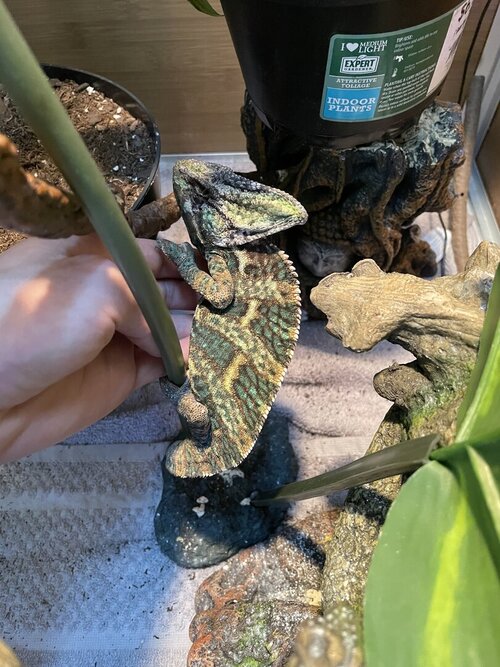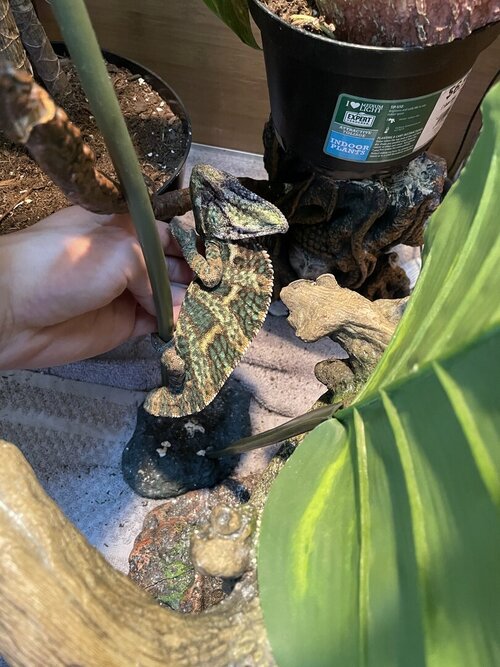So quick little background. Back in February my Cham had some major muscle spasms, so bad that he couldn’t even sit still. I brought him to the vet immediately and they diagnosed him with parasites. They told me I can either give him parasite medication and see if that works or do blood testing and whole body testing for $600. So I chose the medication. About a week later his spams stopped and everything went back to normal. Fast forward to about 2 weeks ago his spasms came back but this time they were very minor, barely even noticeable. I made another vet appointment right away (the first place I took him was a pet emergency room, this place was his primary vet) Before I could even take him to the vet again the spasms stopped and once again everything seemed normal but I took him anyway.
It’s been about 1 week since I took him to the vet. At the vet I explained the muscle spasm situation and how I had to rush him to the hospital and they came to the conclusion that it was calcium deficiency instead of parasites and they gave me a liquid calcium supplement daily. Ever since that visit a week ago he has not eaten anything, not a single bug. But he has been drinking and hydrated. So I assumed he was just stressed from people grabbing him and touching him and stuff. But now I woke up this morning and he was on the very bottom of his cage, not holding on to any branches, just laying there. I genuinely thought he was dead until I poked him and he woke up. Right away I slid my hand under him to pick him up and he started hissing and puffing up at me, acting like his normal self. But he isn’t moving anywhere he’s just sitting on the branch I put him on looking around. I don’t really know what happened here as he seems very healthy. Both of the vets I went to even said he’s one of the most beautiful and healthiest chameleons they’ve ever seen and they congratulated me for doing a good job. So this is very sudden for me. Could it be possible he’s overdosing on calcium from the supplement?
The stressed colors he’s showing in the photos are from me touching him, when I first walked up to the cage he was normal coloration. (Also I know I’m supposed to fill out the form on my chameleon habits but I know I’ve been doing everything right. I follow the normal dusting schedule, I mist when I need to, he has a dripper for water, lighting and temperatures are perfect)
It’s been about 1 week since I took him to the vet. At the vet I explained the muscle spasm situation and how I had to rush him to the hospital and they came to the conclusion that it was calcium deficiency instead of parasites and they gave me a liquid calcium supplement daily. Ever since that visit a week ago he has not eaten anything, not a single bug. But he has been drinking and hydrated. So I assumed he was just stressed from people grabbing him and touching him and stuff. But now I woke up this morning and he was on the very bottom of his cage, not holding on to any branches, just laying there. I genuinely thought he was dead until I poked him and he woke up. Right away I slid my hand under him to pick him up and he started hissing and puffing up at me, acting like his normal self. But he isn’t moving anywhere he’s just sitting on the branch I put him on looking around. I don’t really know what happened here as he seems very healthy. Both of the vets I went to even said he’s one of the most beautiful and healthiest chameleons they’ve ever seen and they congratulated me for doing a good job. So this is very sudden for me. Could it be possible he’s overdosing on calcium from the supplement?
The stressed colors he’s showing in the photos are from me touching him, when I first walked up to the cage he was normal coloration. (Also I know I’m supposed to fill out the form on my chameleon habits but I know I’ve been doing everything right. I follow the normal dusting schedule, I mist when I need to, he has a dripper for water, lighting and temperatures are perfect)







